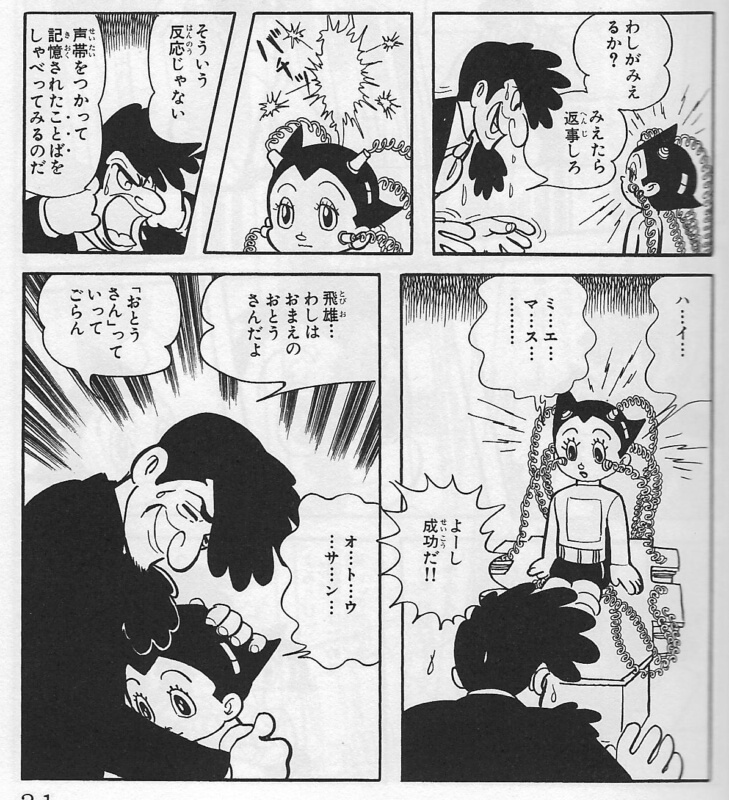 Astro Boy,” the new American computer-animated version of the Japanese comic and cartoon that launched the revolution we now call anime, opens today.
Astro Boy,” the new American computer-animated version of the Japanese comic and cartoon that launched the revolution we now call anime, opens today.
I’m more than a little nervous about seeing the movie, since it may not resemble the Japanese cartoon I grew up with, and because Hollywood really screwed up “Speed Racer” when they decided to turn that classic anime into a big live-action spectacle.
(The following text is a re-worked version of a pre-blog Nikkei View column I wrote back in 2003.)
Astro Boy, called “Tetsuwan Atomu” in Japan, was originally introduced in 1952, as a manga, or comic book character, and later turned into an animated television series. Created by the pioneering Japanese comic and anime (animation) artist Osamu Tezuka, his name stands for “The Mighty Atom,” an image still vivid in the minds of millions of Japanese who had lived through the end of World War II just seven years before, and the atomic bombings of Hiroshima and Nagasaki.
The cartoon character is best-known in the US for the English-dubbed versions of the “Astro Boy” series that first aired in 1963 and then was re-launched with a new series in 1982 and resurrected in a computer-animated film opening today, featuring the voices of Freddie Highmore, Nicolas Cage, Kristen Bell, Bill Nighy and Samuel L. Jackson.
The story line is a spin on Pinocchio and superhero comics, mixed with a dose of Steven Spielberg’s film “A.I.” (actually “A.I.” borrows more than a dose from Astro Boy). When the kindhearted Dr. Boynton’s (Professor Tenna in the Japanese original) son is killed in a car accident, he invents an atomic-powered robotic replacement only to discover that there’s no way that the android can truly be human. The mechanical boy was born on April 7, 2003 — the far future — in the original manga. Continue reading




 Like any school kid, I loved going on field trips when I was young, But, since we lived in Japan until 3rd grade, my earliest memories of field trips weren’t the typical ones that American kids remember. I remember looking out of a school bus and seeing steaming lumps of sticky rice being pounded into mochi for New Year’s celebrations, for example (I think we were on the way to a shrine where we learned about Oshogatsu, or Japanese New Year, traditions).
Like any school kid, I loved going on field trips when I was young, But, since we lived in Japan until 3rd grade, my earliest memories of field trips weren’t the typical ones that American kids remember. I remember looking out of a school bus and seeing steaming lumps of sticky rice being pounded into mochi for New Year’s celebrations, for example (I think we were on the way to a shrine where we learned about Oshogatsu, or Japanese New Year, traditions). 
 Here’s the caption from Disgrasian. Clockwise from top left: Wacky Hiro Nakamura from Heroes, Wacky Engrish-Speaking Kentucky Fried Chicken-Grilled Chicken Lovers, I Survived a Japanese Game Show’s Wacky Host Rome Kanda, Wacky Engrish-Speaking Six Flags Guy.
Here’s the caption from Disgrasian. Clockwise from top left: Wacky Hiro Nakamura from Heroes, Wacky Engrish-Speaking Kentucky Fried Chicken-Grilled Chicken Lovers, I Survived a Japanese Game Show’s Wacky Host Rome Kanda, Wacky Engrish-Speaking Six Flags Guy. What’s odd about this ad campaign is that the Japanese in the past have sort of worshiped Westerners as spokespeople for their ad campaigns. I remember seeing Arnold Schwarzenegger dressed as a samurai for a ramen company, and
What’s odd about this ad campaign is that the Japanese in the past have sort of worshiped Westerners as spokespeople for their ad campaigns. I remember seeing Arnold Schwarzenegger dressed as a samurai for a ramen company, and Consumer culture in Japan is where you’ll see the collision of Asian and American tastes. More than in the U.S., Japan is where East mashes West. You can get shrimp Filet-o-Fish sandwiches at McDonald’s, or pizza with seaweed or squid, and spaghetti with salty plum sauce.
Consumer culture in Japan is where you’ll see the collision of Asian and American tastes. More than in the U.S., Japan is where East mashes West. You can get shrimp Filet-o-Fish sandwiches at McDonald’s, or pizza with seaweed or squid, and spaghetti with salty plum sauce.






